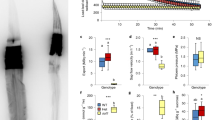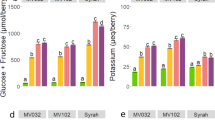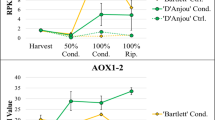Abstract
IN phloem translocation systems, sources and sinks are clearly defined: sources are net exporters and sinks net importers of carbon compounds. The overall rate of translocation is largely controlled by ill-defined metabolic processes operating at the source and sink, the transport process itself rarely being limiting1–3. An understanding of how this control is exerted is needed before the mechanism of phloem translocation can be understood, and may provide the potential for manipulating the yield of the economically important parts of plants. The direction of net translocation is reversed as a growing leaf matures3,4, or when previously imported material is redistributed from storage organs such as bulbs5,6. In such cases, however, it is difficult to relate causally the physiology or biochemistry of the organ to the change in the direction of translocation. Previous attempts to convert mature leaves from net exporters to net importers have been only partially successful7–10. We have now achieved complete reversal of the normal role of a sink, and report here the net export of considerable quantities of carbon from a young, growing tomato fruit.
This is a preview of subscription content, access via your institution
Access options
Subscribe to this journal
Receive 51 print issues and online access
$199.00 per year
only $3.90 per issue
Buy this article
- Purchase on Springer Link
- Instant access to full article PDF
Prices may be subject to local taxes which are calculated during checkout
Similar content being viewed by others
References
Milthorpe, F. L., and Moorby, J., A. Rev. Pl. Physiol., 20, 117–138 (1969).
Wareing, P. F., and Patrick, J. W., in Photosynthesis and Productivity in Different Environments, 3, 481–499 (International Biological Programme, 1975).
Wardlaw, I. F., Bot. Rev., 34, 79–105 (1968).
Turgeon, R., and Webb, J. A., Planta, 113, 179–191 (1973).
Ho, L. C., and Rees, A. R., New Phytol., 74, 421–428 (1975).
Ho, L. C., and Rees, A. R., New Phytol., 76, 59–68 (1976).
Mason, T. G., and Maskell, E. J., Ann. Bot., 42, 571–636 (1928).
Mason, T. G., Maskell, E. J., and Phillis, E., Ann. Bot., 50, 23–58 (1936).
Palmquist, E. M., Am. J. Bot., 25, 97–105 (1938).
Thrower, S. L., New Phytol., 73, 685–687 (1974).
Ho, L. C., Rep. Glasshouse Crops Res. Inst., 43 (1972).
Geiger, R., Pl Physiol, Lancaster, 41, 1667–1672 (1966).
Wardlaw, I. F., in Mechanisms of Regulation of Plant Growth, Bulletin 12, 533–538 (The Royal Society of New Zealand, Wellington, 1974).
Ho, L. C., J. exp. Bot., 27, 87–97 (1976).
Author information
Authors and Affiliations
Rights and permissions
About this article
Cite this article
WALKER, A., HO, L. Young tomato fruits induced to export carbon by cooling. Nature 261, 410–411 (1976). https://doi.org/10.1038/261410a0
Received:
Accepted:
Issue Date:
DOI: https://doi.org/10.1038/261410a0
Comments
By submitting a comment you agree to abide by our Terms and Community Guidelines. If you find something abusive or that does not comply with our terms or guidelines please flag it as inappropriate.



